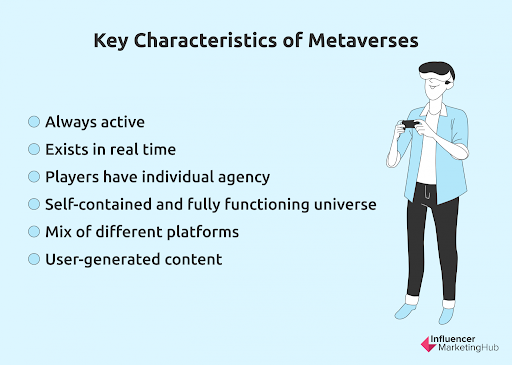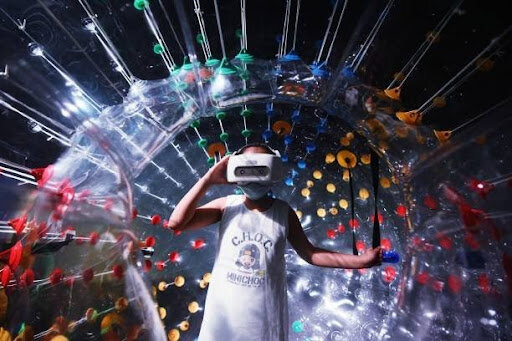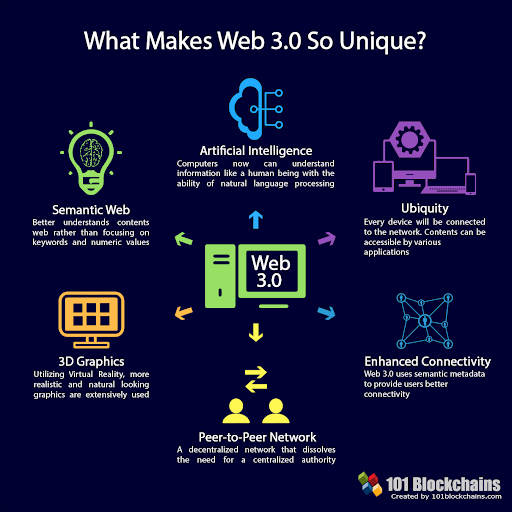What the Metaverse Is and Why It Matters for Social Media Marketers
The Metaverse has been a hot topic on social media ever since Facebook announced its company-wide name change to Meta at the end of last year, alongside a new focus in bringing the Metaverse to life.
Despite the buzz, it can be hard to get to grips with what exactly the Metaverse is and its relevance to those of us working in social media in the present.
What is the Metaverse
The Metaverse is a future evolution of the internet as we know it, utilising AR, VR and the Internet of Things (IoT), among other technologies; it’s a future network of 3D virtual worlds that can be accessed in real-time through virtual avatars and potentially overlay our experience of the physical world.
Because we are decades away from the technological advancements needed to make the Metaverse a reality, even experts find it hard to define what exactly it will look like. Some describe it as the transition from the internet as a place we visit through a physical interface i.e. computers and mobile devices, to the internet as a place we are constantly within.
Others envision it as a kind of VR social media, with several key Metaverses we visit akin to the popular social media platforms of today.
Image Source: Influencer Marketing Hub
Why the Metaverse matters for social media marketers
One thing is clear - components of the Metaverse’s foundation are growing in popularity. And because they are, brands are paying more attention and investing in VR spaces, gaming and immersive experiences that best echo what the Metaverse could become.
Image Source: Influencer Marketing Hub
‘Coca-Cola, Samsung, and Volkswagen all have virtual billboards within video games like Football Manager and Hyper Scape. The in-game advertising platform Bidstack revealed that these ads enhanced gameplay realism for 95% of players and increased purchase intent by 12%.’ - Influencer Marketing Hub
Marketing professionals who are up to date on this technology have the edge as more companies seek employees who are literate in all things Metaverse and can better assist in related strategies.
So let’s break down the key terminologies that make up the Metaverse:
AR
The simulation of artificial objects in real world environments using computer generated perceptual information, like from a camera. Sometimes these objects are enhancements of existing physical objects and sometimes they are enhanced across multiple sensory formats like touch, smell and sound.
AR can be found in Snapchat and Instagram filters, games like Pokemon Go, and Pinterest’s new ‘AR Try On for Home Decor’ feature.
Image Source: Marc Bruxelle/Shutterstock.com
VR
The use of computer technology, namely a head-mounted display set and handset i.e. the Oculus Quest, to create a simulated environment with which a person can interact. It’s at the core of the concept of the Metaverse and what most people are experiencing the Metaverse as today.
The most popular VR gaming worlds at the moment include Minecraft, Roblox, Beat Saber and Skyrim.
Image Source: Getty Images
IoT
A network of physical objects which are embedded with sensors, processors, software and other technologies for the purpose of sharing data with each other without needing any human involvement, over the internet or through other communications networks. Examples of IoT devices include smartwatches/wearables like Fitbits and smart home systems like the Amazon Echo.
‘Over the past few years, IoT has become one of the most important technologies of the 21st century. Now that we can connect everyday objects—kitchen appliances, cars, thermostats, baby monitors—to the internet via embedded devices, seamless communication is possible between people, processes, and things’ - Oracle
Image Source: Avast
Web 3.0
The concept for an upcoming third generation of the internet which is based on blockchain technology, decentralising the internet and putting users first - allowing them ownership of and compensation for their data, without needing permission from a central authority to post.
‘Websites and apps will be able to process information in a smart human-like way through technologies like machine learning (ML), Big Data, decentralized ledger technology (DLT), etc. Web 3.0 was originally called the Semantic Web by World Wide Web inventor Tim Berners-Lee, and was aimed at being a more autonomous, intelligent, and open internet’ - CoinMarketCap
Image Source: 101 Blockchains
Image Source: Enlear Academy
NFTs
Unique and non-interchangeable units of data attributed to digital items, which are then logged on blockchain technology that establishes proof of ownership. Digital items which can become NFTs range from music to photography to game items.
The famed ‘Disaster Girl’ meme became an NFT.
Image Source: Dave Roth
And celebrity socialite Paris Hilton made her own NFT series in collaboration with artist Blake Kathryn.
Image Source: Paris Hilton and Blake Kathryn, ICONIC CRYPTO QUEEN/ArtNet
Blockchain
A decentralised digital ledger where transactions made in various cryptocurrencies are publicly recorded in chronological order and maintained across several computers linked in a peer-to-peer network.
‘Unlike political regulation, blockchain governance is not emergent from the community. Rather, it is ex ante, encoded in the protocols and processes as an integral part of the original network architecture. To be a part of a community supporting a blockchain is to accept the rules of the network as they were originally established’ - Harvard Business Review
Image Source: Euromoney Learning
Cryptocurrency
A virtual peer-to-peer payment system that doesn’t rely on bank verification because it uses encryption to verify transactions. Popular cryptocurrencies include Bitcoin, Ethereum and Binance Coin.
‘A cryptocurrency is a form of digital asset based on a network that is distributed across a large number of computers. This decentralized structure allows them to exist outside the control of governments and central authorities’ - Investopedia
Image Source: TechRepublic
Want to future-proof your marketing career and keep up to date with all Metaverse-related developments in social? Sign up to the SocialDay weekly newsletter for the latest social media news.






















